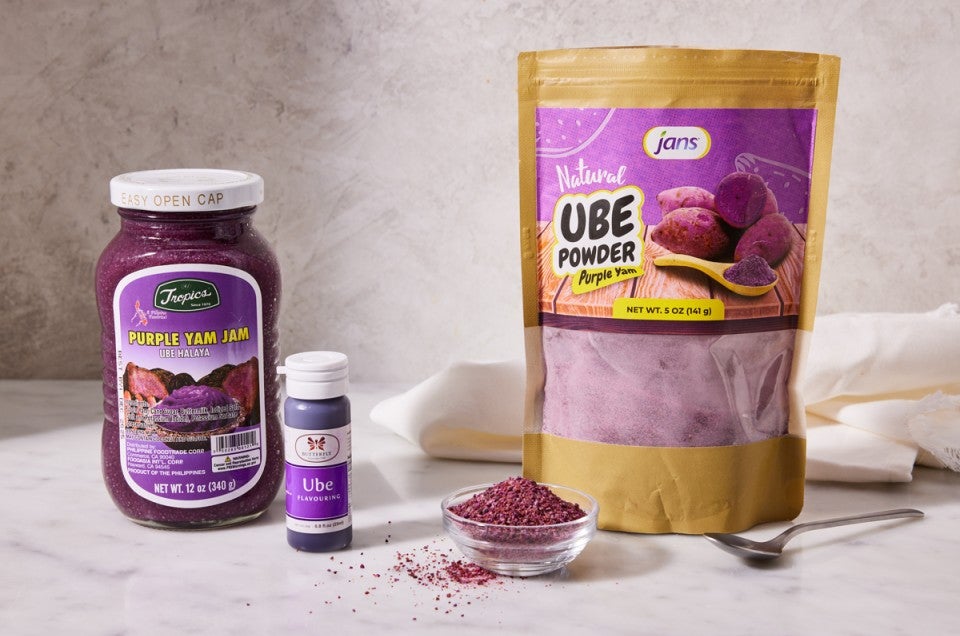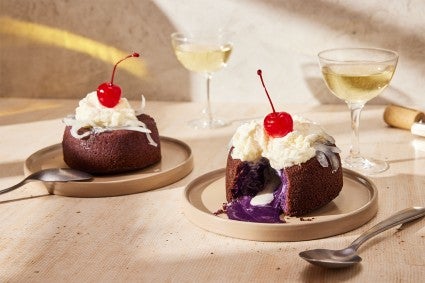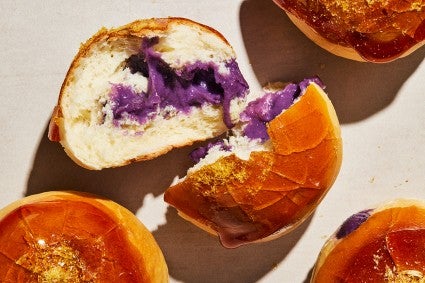Your guide to baking with ube
This striking purple tuber adds delicate flavor and stunning color to your baking.


If you’ve noticed a surge of purple desserts popping up on menus, dominating social media feeds, and gracing the pages of culinary magazines, you're not alone. From Michelin star tasting menus to specialty grocery stores, it seems ube is everywhere. Having grown up savoring ube halaya at every celebration and requesting an ube birthday cake year after year, the recent explosion of ube's popularity fills me with immense pride. But what exactly is ube, and how can you use it to create your own stunning purple bakes?
Ube is a type of purple yam native to Southeast Asia. It’s a prized ingredient in Filipino cuisine, used in both traditional desserts like ube halaya (a pudding-like dessert) and kakanin (rice cakes), and modern desserts like cakes, cookies, and ice cream. A symbol of celebration, no holiday gathering or festive occasion is complete without at least one ube dessert on the table.
Though often mistaken for purple sweet potatoes, ube is a distinct species. While they share the same captivating color inside, ube has a rough, thick exterior that looks a bit like tree bark. It also boasts a sweeter, more aromatic flavor than purple sweet potatoes, and imparts a richer, darker color to dishes. While purple sweet potatoes are easier to find in specialty grocery stores, buying fresh purple yams in the United States can still be a challenge. However, due to the ongoing popularity of ube desserts, other forms of ube are becoming increasingly accessible, and most are great for baking.

With its captivating purple hue, it's clear why ube has surged in popularity, especially in the age of visual platforms like Instagram and TikTok. But what gives ube the potential to be a culinary staple isn’t just its attention-grabbing color, but its enigmatic flavor. Ube is earthy with a milky flavor reminiscent of white chocolate, notes of coconut, rich nutty pistachio, and aromatic vanilla. While challenging to pin down in words, ube's flavor translates beautifully across the culinary spectrum, and it tastes delicious in everything from doughnuts and macarons to lattes and cocktails.
The type of ube product you should purchase will greatly depend on what you want to bake. Different forms of ube products can greatly affect the texture of your bake, so different recipes will call for a specific form of ube. Here are the most common ones.
Sourcing and baking with fresh ube is quite a challenge. It is rarely imported into North America, but it can sometimes be found in Asian grocery stores. In the Philippines, it’s primarily used to make ube halaya, a unique dessert served on special occasions that doesn’t have an American equivalent. It’s a bit like sweet potato casserole, but with a thicker and more substantial consistency since ube is starchier than sweet potatoes.
To make it, mashed ube is simmered and stirred into copious amounts of butter, sugar, and coconut milk. (Some recipes call for sweetened condensed milk instead.) Although the dessert may look simple, it’s a laborious process that requires constant attention to prevent it from scorching and sticking. It's a labor of love and a bit of an arm workout.

Ube jam is commonly found in the Filipino section of many Asian grocery stores, online, and even at Trader Joe’s. This versatile ingredient can be easily incorporated into various recipes, including cake batter and cookie dough (like these Mochi-Stuffed Ube Crinkle Cookies). It comes sweetened and makes a delicious filling for layer cake or sweet buns, similar to how you'd use red bean paste.
Confusingly, ube jam is often referred to as ube halaya in the States, both in recipes and products found in stores and online. However, in the Philippines, the two are totally different. Ube jam is a little thinner and more spreadable than traditional halaya. It is not usually enjoyed on its own and is instead spread on top of bread like Pandesal or white sandwich bread.
Readily available in the freezer section of most Asian grocery stores, frozen ube is made from cooked, grated, or mashed ube. It’s a convenient substitute for fresh in most recipes, and like fresh ube, you can use it to make halaya. Once defrosted, you can add it directly to dough or batter for cookie, bread, and cake recipes, much like you would use pumpkin or sweet potato purée.
Ube powder, also known as purple yam powder, can be found in most Asian grocery stores, online, and increasingly at some health food stores. For most recipes, it needs to be reconstituted into a paste by adding a little water. Since it’s made from cooked, dehydrated, and ground ube, it imparts a grainy texture to baked goods. In some cases, that can be a good thing! In my recipe for Ube White Chocolate Macadamia Sourdough Cookies, I’ve found that the addition of ube powder imparts a delightful heartiness that adds to the overall textural experience of the cookies.
Ube powder works great for lattes, ice cream, cakes, and bread. Since it retains a subtle texture, it may not be ideal for custard fillings, pudding, or flan where a perfectly smooth and silky consistency is desired. It also adds a more subtle flavor and color than other forms of ube, so for a deeper purple hue and a more intense ube taste, it’s best to use extract.

Ube extract is made from steeped purple yam, food coloring, and natural flavors; it’s conveniently available in the Filipino section of most Asian grocery stores and online. If you’re looking to add an intense ube flavor and bold purple color to your bakes, ube extract is your best bet. It's particularly suited to creamy fillings, as showcased in this Ube Bibingka Custard Buns recipe. Ube extract is also perfect for adding color and flavor to meringues, macarons, brownies, cakes, cookies, and even cocktails.
If you're unfamiliar with ube and want to give it a try, using ube extract is the easiest way to introduce its unique flavor to your baking since it won’t alter the texture of your bake. You can easily swap out vanilla for ube extract at a 1:1 ratio in your dough or batter. Since its flavor is quite subtle (unlike almond or orange extract), it's tough to go overboard, and you can always add more if you're aiming for a richer purple hue.
Beyond its status as a darling of social media, ube is a treasured ingredient steeped in heritage. Filipinos hold their culinary traditions dear, and ube is one of our most cherished ingredients. Witnessing its rise to prominence feels like a long-awaited validation of our rich food culture, especially within the Western world where Filipino cuisine hasn't always received the recognition it deserves compared to other Asian cuisines. With its increasing popularity, ube is now more readily available, so it’s easier than ever to start using it in your own baking!
For more classic Filipino bakes, try creamy Filipino Egg Pie, crispy, crunchy Silvanas, and this pillowy-soft Giant Ensaymada.
Cover photo by Rick Holbrook; food styling by Sheila Jarnes.


